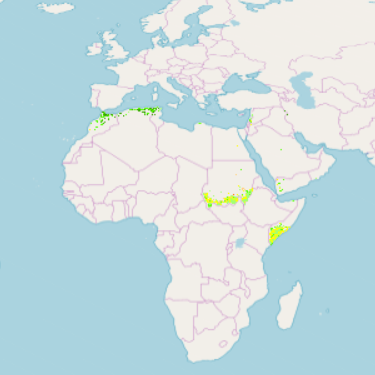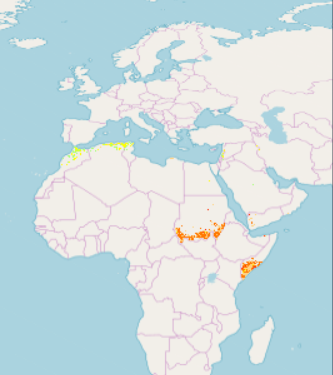Water
Type of resources
Available actions
Topics
Keywords
Contact for the resource
Provided by
Formats
Representation types
Update frequencies
status
-
This layer is provided by the Ministry of Public Works.
-

This raster dataset provides a representation of the change in exposure (vulnerability assessment) for climate change impact sector:subsector - People: Human Health Conditions due to Heat Stress - in the Middle East and North Africa Region. Vulnerability is a concept used to express the complex interaction of climate change effects and the susceptibility of a system to its impacts. In the context of climate change, exposure refers to changes in climate parameters that might affect socio-ecological systems. The integrated vulnerability assessment combines a series of single vulnerability assessments for several water-related climate change impacts on different sectors. It adopts the time periods generally used by the Intergovernmental Panel for Climate Change (IPCC) and other regional climate modelling experiments, and runs climate simulations based on future time periods that are compared with a historical reference period. The adopted future time periods are: Mid-Century (2046-2065); End-Century (2081-2100). Available at approximately 1km pixel resolution, the raster grids are generated for moderate and high representative concentration pathways (RCPs), emission scenarios developed by the Intergovernmental Panel on Climate Change (IPCC) for informing global and regional climate modelling work (RCP4.5 and RCP8.5). Grid pixel values are classified according to a level of exposure (1 to 10), for the sector:subsector: - People: Human Health Conditions due to Heat Stress;
-

Part of the Integrated Vulnerability Assessment in the Arab Region, this 1km pixel resolution raster dataset provides a representation of future change in vulnerability hotspots for People:Water Available for Drinking sub-sector, in the Middle East and North Africa Region. The raster grid was generated for End-Century time period (2081-2100) and high emission scenario - representative concentration pathway (RCP8.5) - developed by the Intergovernmental Panel on Climate Change (IPCC). Pixel values were classified according to vulnerability level: class 10 the top 10%, class 20 top 20% and class 30 top 30%. Vulnerability is a concept used to express the complex interaction of climate change effects and the susceptibility of a system to its impacts. The integrated vulnerability assessment methodology is based on an understanding of vulnerability as a function of a system’s climate change exposure, sensitivity and adaptive capacity to cope with climate change effects, consistent with the approach put forward by the IPCC in its Fourth Assessment Report (AR4). It adopts the time periods generally used by the IPCC and other regional climate modelling experiments and runs climate simulations based on future time periods that are compared with a historical reference period.
-

Part of the Integrated Vulnerability Assessment in the Arab Region, this 1km pixel resolution raster dataset provides a representation of change in Potential Impact, for climate change impact sector:subsector – Biodiversity and Ecosystems: Area Covered by Forests - in the Middle East and North Africa Region. Vulnerability is a concept used to express the complex interaction of climate change effects and the susceptibility of a system to its impacts. Within the Vulnerability Assessment conceptual framework, Exposure refers to changes in climate parameters that might affect socio-ecological systems, Sensitivity provides information about the status quo of the physical and natural environment that makes the affected systems particularly susceptible, and the Potential Impact is determined by combining the exposure and sensitivity of a system. The integrated vulnerability assessment combines a series of single vulnerability assessments for several water-related climate change impacts on different sectors. It adopts the time periods generally used by the Intergovernmental Panel for Climate Change (IPCC) and other regional climate modelling experiments, and runs climate simulations based on future time periods that are compared with a historical reference period. The raster grids, with classified pixel values, from low Potential Impact 1 to high Potential Impact 10, are generated for moderate and high representative concentration pathways (RCP4.5 and RCP8.5), emission scenarios developed by the Intergovernmental Panel on Climate Change (IPCC) for informing climate modelling work, and for future time periods: Mid-Century (2046-2065); End-Century (2081-2100).
-

Part of the Integrated Vulnerability Assessment in the Arab Region, this 1km pixel resolution raster dataset provides a representation of Potential Impact to climate change for impact sector:subsector – Biodiversity and Ecosystems: Area Covered by Wetlands - in the Middle East and North Africa Region, 1986-2005 reference period. Vulnerability is a concept used to express the complex interaction of climate change effects and the susceptibility of a system to its impacts. Within climate the vulnerability assessment conceptual framework, Exposure refers to changes in climate parameters that might affect socio-ecological systems, Sensitivity provides information about the status quo of the physical and natural environment that makes the affected systems particularly susceptible, and Potential Impact is determined by combining the exposure and sensitivity of a system. The integrated vulnerability assessment combines a series of single vulnerability assessments for several water-related climate change impacts on different sectors. It adopts the time periods generally used by the Intergovernmental Panel for Climate Change (IPCC) and other regional climate modelling experiments, and runs climate simulations based on future time periods that are compared with a historical reference period. The raster grid (GeoTiff raster file) is available for 1986-2005 reference period, with classified pixel values, from low Potential Impact 1 to high Potential Impact 10.
-
RICCAR, MENA Region - Vulnerability Assessment Output - Water - High emission scenario (End-Century)

Part of the Integrated Vulnerability Assessment in the Arab Region, this 1km pixel resolution raster dataset provides a representation of future change in vulnerability for Water sector, in the Middle East and North Africa Region. The Raster grid was generated for high representative concentration pathway (RCP8.5) emission scenario developed by the Intergovernmental Panel on Climate Change (IPCC), for time period End-Century (2081-2100). Pixel values are classified according to level of vulnerability, from low 1 to high 10. Vulnerability is a concept used to express the complex interaction of climate change effects and the susceptibility of a system to its impacts. The integrated vulnerability assessment methodology is based on an understanding of vulnerability as a function of a system’s climate change exposure, sensitivity and adaptive capacity to cope with climate change effects, consistent with the approach put forward by the IPCC in its Fourth Assessment Report (AR4). It adopts the time periods generally used by the IPCC and other regional climate modelling experiments and runs climate simulations based on future time periods that are compared with a historical reference period.
-

Part of the Integrated Vulnerability Assessment in the Arab Region, this 1km pixel resolution raster dataset provides a representation of future change in vulnerability for People: Water Available for Drinking sub-sector, in the Middle East and North Africa Region. The Raster grid was generated for moderate representative concentration pathway (RCP4.5) emission scenario developed by the Intergovernmental Panel on Climate Change (IPCC) for time period End-Century (2081-2100). Pixel values are classified according to level of vulnerability, from low 1 to high 10. Vulnerability is a concept used to express the complex interaction of climate change effects and the susceptibility of a system to its impacts. The integrated vulnerability assessment methodology is based on an understanding of vulnerability as a function of a system’s climate change exposure, sensitivity and adaptive capacity to cope with climate change effects, consistent with the approach put forward by the IPCC in its Fourth Assessment Report (AR4). It adopts the time periods generally used by the IPCC and other regional climate modelling experiments and runs climate simulations based on future time periods that are compared with a historical reference period.
-

Part of the Integrated Vulnerability Assessment in the Arab Region, this 1km pixel resolution raster dataset provides a representation of future change in vulnerability for Water sector, in the Middle East and North Africa Region. The Raster grid was generated for moderate representative concentration pathway (RCP4.5) emission scenario developed by the Intergovernmental Panel on Climate Change (IPCC) for time period End-Century (2081-2100). Pixel values are classified according to level of vulnerability, from low 1 to high 10. Vulnerability is a concept used to express the complex interaction of climate change effects and the susceptibility of a system to its impacts. The integrated vulnerability assessment methodology is based on an understanding of vulnerability as a function of a system’s climate change exposure, sensitivity and adaptive capacity to cope with climate change effects, consistent with the approach put forward by the IPCC in its Fourth Assessment Report (AR4). It adopts the time periods generally used by the IPCC and other regional climate modelling experiments, and runs climate simulations based on future time periods that are compared with a historical reference period.
-

Part of the Integrated Vulnerability Assessment in the Arab Region, this 1km pixel resolution raster dataset provides a representation of Adaptive Capacity to climate change for impact sector:subsector – People: Human Health Conditions due to Heat Stress - in the Middle East and North Africa Region. Vulnerability is a concept used to express the complex interaction of climate change effects and the susceptibility of a system to its impacts. The integrated vulnerability assessment methodology is based on an understanding of vulnerability as a function of a system’s climate change exposure, sensitivity and adaptive capacity to cope with climate change effects, consistent with the approach put forward by the Intergovernmental Panel on Climate Change (IPCC) in its Fourth Assessment Report (AR4). Combining exposure, sensitivity and adaptive capacity allows assessing the vulnerability of a system to climate change. The integrated vulnerability assessment combines a series of single vulnerability assessments for several water-related climate change impacts on different sectors. Adaptive capacity Indicators were assumed to retain the same values for the reference period and future periods, and raster grid pixel values were classified according to level of Adaptive Capacity, from low 1 to high 10.
-
RICCAR, MENA Region - Vulnerability Assessment Output - Water - High emission scenario (Mid-Century)

Part of the Integrated Vulnerability Assessment in the Arab Region, this 1km pixel resolution raster dataset provides a representation of future change in vulnerability for Water sector, in the Middle East and North Africa Region. The Raster grid was generated for high representative concentration pathway (RCP8.5) emission scenario developed by the Intergovernmental Panel on Climate Change (IPCC), for future time period Mid-Century (2046-2065). Pixel values are classified according to level of vulnerability, from low 1 to high 10. Vulnerability is a concept used to express the complex interaction of climate change effects and the susceptibility of a system to its impacts. The integrated vulnerability assessment methodology is based on an understanding of vulnerability as a function of a system’s climate change exposure, sensitivity and adaptive capacity to cope with climate change effects, consistent with the approach put forward by the IPCC in its Fourth Assessment Report (AR4). It adopts the time periods generally used by the IPCC and other regional climate modelling experiments, and runs climate simulations based on future time periods that are compared with a historical reference period.
 FAO Map Catalog
FAO Map Catalog